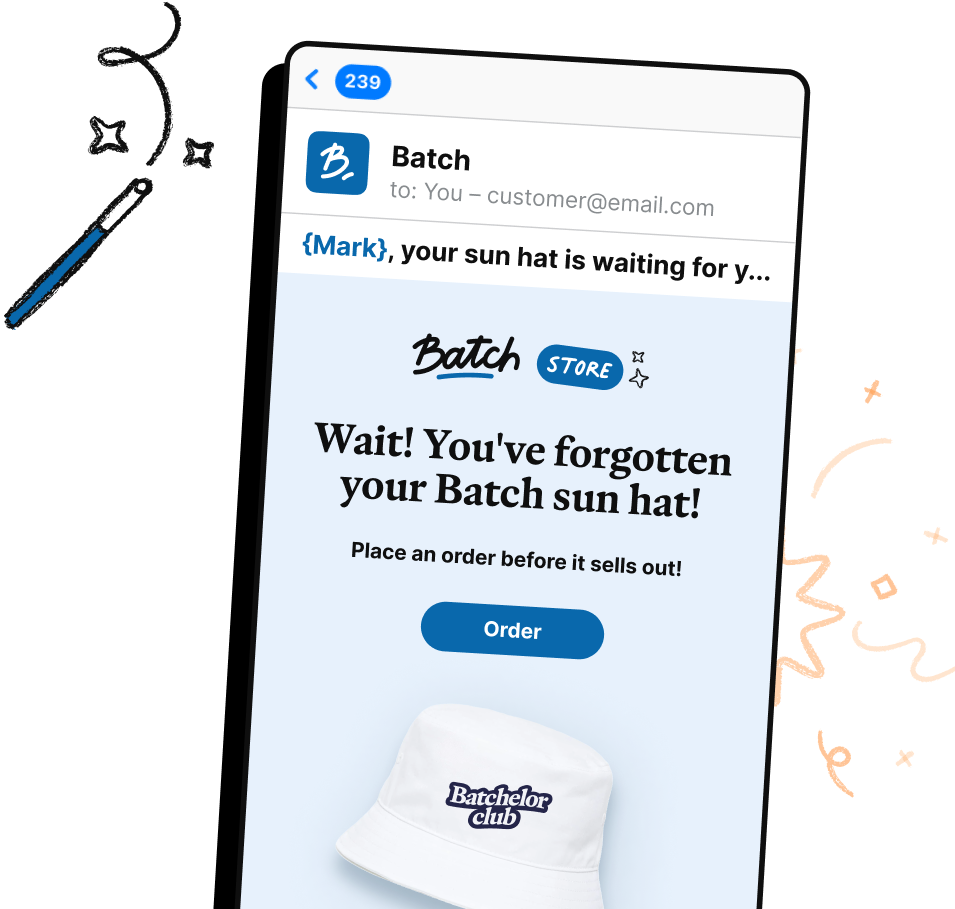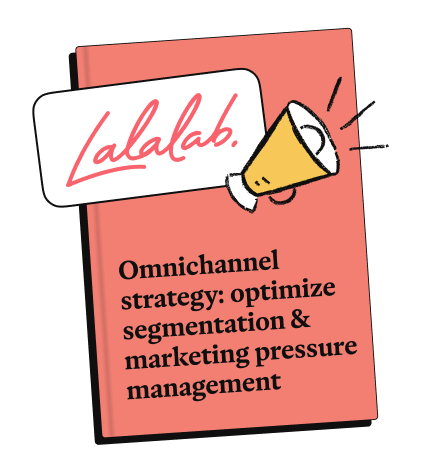Channels
How to engage your customers with email marketing
No, emails aren’t out. Quite the opposite, in fact! It’s the channel most commonly used by marketers: of our 350 clients in Europe, 95% use it as their primary CRM channel.

What are the best practices for creating effective email marketing? Which solution to use to send them to the right people? Here's how to optimise your email campaigns!
Why you should adopt an email marketing strategy
What is email marketing?
Some key figures
By 2025, the total number of email users should increase and reach 4.6 billion.¹
Forecasts expect that 376.4 billion emails will be sent and received every day in the world in 2025, compared to 319.6 billion in 2021.²
Email marketing is an ROI communication channel: for every euro invested, the return on investment will be €40.³
Emails are essential if you want to achieve your marketing strategy goals. They give your recipient a call to action (make a purchase, fill in a contact form, view a page, etc.), which plays a vital role in engagement and conversion.
What advantages of email marketing?
Email is a channel that offers great freedom. It is a mature channel that does not belong to a single company, unlike Facebook, Messenger or WhatsApp messaging services. You can truly make it your own and be very creative without having to worry about sudden changes to terms of use.
Emails are universal. Everyone (or nearly everyone) has a mailbox and an email address. There’s no need to download an app or sign up to a given social media platform. Everyone can access it easily!
With email, you can make a difference. You can structure your message as you like, with images, text, dynamic content and so on. That way it will correspond to you, your identity and what sets you apart from your competitors.
Emails can be highly personalised. You can adapt the entire content to the recipient. You can also change when you send emails, adapt to when emails are opened, and the device used.
Email marketing & push notifications: two channels that complement each other perfectly
With push notifications, you can send short messages at the right time to engage quickly on a specific topic. Emails meanwhile can be sent when the audience has time to read longer, more in-depth content.
By combining these two tools, you have a powerful means of ensuring engagement and conversion.
What kinds of emails are there?
Emails sorted by type
Promotional emails designed to showcase your products or special offers, adapted as much as possible to the recipient’s profile.
Transactional emails (also known as service emails) include messages relating to a transaction: welcome emails following sign-up, order confirmation, upcoming delivery, etc. They are quite short and are free of marketing talk. They do not require an opt-in.
Branding emails designed to strengthen a customer’s ties to your brand. They can promote special offers but, above all, they showcase content (videos, events, social media content, etc.) and the brand’s values. What matters most is that the content is adapted as far as possible to the intended audience.
Emails sorted by time or frequency
Marketing emails sent via list segmentation on very specific dates or occasions: sales or the release of a new feature, for example.
Trigger and remarketing emails sent throughout the customer lifecycle or following an event (for example, when a customer account is created or the marketing score for a customer exceeds a certain threshold). They are automated, targeted with due care and personalised.
Making your email campaigns a success: best practices
Personalise your emails
With a properly customised email, there is a greater chance that the recipient will be receptive to your message.
To do so, you can use the profile data collected as you interact with the customer. You can also identify the preferences of each via a preference centre. The recipients themselves can manage the content and frequency of emails.
Here are some customisation possibilities to test out on your audience:
Adapt content sections: use text and images, direct your target audience to content that corresponds to their expectations.
Recommend products or services based on the recipient’s purchase or browser history.
Use specific calls to action based on the customer’s situation. Invite them to join the next conference, sign up to a particular newsletter or the
There are so many options! But one thing is sure: a high level of customisation requires the right automated scenarios.
You must make sure that the email does indeed direct the person to things they are interested in. For example, there’s no point in talking about a new feature to someone who hasn’t bought the product! This requires targeted customisation and properly segmenting your database according to profiles, statuses, etc.
Write for your target audience, and with your goal in mind
Each email must correspond to a very specific aim that has been defined beforehand – what action do you want your recipient to take? That will guide how you create your email, from choosing the subject to the call to action.
Remember to push the benefits for your recipient, and write as if you were talking to them directly, not a large contact list. They need to feel a certain degree of closeness; that also entails using the right personalisation fields (first name, situation, and so on).
Lastly, it is vital you take the time to write a good subject line. You must make it attractive so that it stands out in the inbox. It’s essential if you want your marketing email to be opened and read! To ensure that happens, some companies use seasoned copywriters.
Enhance your design
Of course, a good email uses the brand’s visual and graphical charter to get across its identity. It must catch the eye, but it must also have a responsive design so that it displays correctly on all media (mobile phones, desktops, tablets, etc.). Good HTML integration must also enable the email to adapt to all types of devices.
Whether Outlook, Gmail or other mailbox providers, platforms too can vary. But the content must continue to be readable, no matter how it is read. Here are some elements to watch out for: dark mode, dynamic content displays such as GIFs, and image sizing.
You have two solutions:
Limit yourself to an email that is effective in most contexts (but that would be a shame!);
Go further by customising content according to audience targeting, taking into account preferred media and display preferences.
Ensure accessibility and green designs
Are your actions now governed by a CSR policy? In which case, so are your marketing emails!
To ensure accessibility, you must bear in mind any disabilities. Your message must also be directed to people with a visual impairment in particular. Around 2.2 billion people have a visual impairment that affects their near or far vision.4. Some use a voice assistant that will read the HTML version of the email, rather than the raw text. As such, the development must be adapted and have the right tags.
To ensure your emails have a green design, you must find the right ways to reduce the amount of energy and resources needed to produce, store, display and send them. Want an example? Avoid attachments, prefer text over images, and choose the lightest possible formats.
Make sure your omni-channel scenario is consistent
Given the importance of mobility and social media, marketing emails are now part of omni-channel marketing. This form of marketing combines emails, mobile push notifications, web push notifications, text messages, and so on.
So don’t talk to the same customer in a different way on different channels: you need to be consistent. Here are three areas that will enable you to manage omni-channels properly:
Rebound. If an email does not generate engagement after two attempts, opt for the push notification channel instead. Try engaging with someone with a push notification before engaging via SMS, which is more expensive to send.
Use preferences, and pay attention to preferences depending on the person or time of day. In general, people will be more likely to look at an email at the beginning or end of a day, or at lunch. Meanwhile, a mobile push notification can be opened immediately at any time.
Avoid conflicts. If someone has reacted negatively to an email on a given topic, it’s best to exclude them from the push notification on the same topic.
Whatever you choose, make sure you have a unified database to communicate effectively across all channels.
Manage marketing pressure
Your audiences receive many messages and the spam button is just a click away. To avoid people unsubscribing, keep an eye on the marketing pressure and the amount of content sent to each person.
Set up rules to limit the volume of messages received by each person, taking all channels into account.
Make sure you have exit events to allow contacts to leave as soon as the goal has been achieved or a condition for exclusion met. For example, a customer complaining about a malfunction should be excluded from any additional sales campaigns following a purchase.
How Lalalab optimises the execution of its omnichannel strategy with Batch
Discover how Lalalab optimizes the complementarity of its channels, the management of marketing pressure and its retargeting campaigns.

Watch your deliverability
For an email to work, it must reach your recipient’s inbox. There are three types of deliverability incidents that can occur:
Your email lands in an ancillary inbox. If it is not marked as important or a priority email, your email can land in a secondary inbox, for example Gmail’s “Promotions” tab rather than the main inbox.
Your email lands in the spam folder, identified as such because it is part of a bulk send operation for advertising purposes.
Your email is blocked. The company managing the mailbox (Orange, Microsoft, Google, etc.) can reject your messages automatically upon receipt. Worse still, it can blacklist your address or domain name.
How to avoid spam?
Circumventing the anti-spam filters of intermediaries, Internet suppliers or mailbox service providers is crucial. A poorly formatted email, or one that uses trigger words, can quickly land in the spam folder.
The rules change, but we recommend you watch out for certain key points:
format: avoid excessively using bold, capital letters and fonts that are too large. Strike a good balance between images/texts and links/texts, and observe best HTML practices for email.
spam words: avoid certain trigger words that have been identified by mailboxes: “free”, “risk-free”, and so on.
number of emails sent in one go: try not to drastically increase the number of emails sent at the same time.
Manage opt-in/opt-out flows
Opt-in is when a person consents to promotional emails from your brand. The regulations change depending on the country. In Germany, for example, double opt-in is the norm: after signing up via a form, a validation email is sent to the person. In Europe, the General Data Protection Regulations (GDPR) apply. Lastly, in France, Articles L32 et seq. of the Post and Electronic Communications Code must be also observed.
The challenge is to manage opt-in and opt-out flows properly. For example, it would be a shame to see a person unsubscribe from all forms of communication after clicking on “Unsubscribe”. This is especially true when all they wanted to do was no longer receive a certain type of email.
And all the more so given that when a relationship between you and your recipient stops, you will have to go through many steps to get the person to resubscribe. Therefore, it is better to prevent the relationship from potentially ending forever.
What’s more, depending on the sectors of activity and the context, some emails are subject to opt-outs, others to opt-ins, or else neither. These elements need to be managed with care to comply with legislation and customer expectations.
Batch's tip
Encourage your user to define the frequency and type of messages they want to receive via a preference center. That way, they control their relationship with your brand.
Which email solution should you choose?
A CRM solution is essential to configure customised scenarios, and create and send emails independently. But which criteria should you take into account to choose the right one?
Connectivity
There’s no point having email marketing if there isn’t an overall digital marketing strategy. Your solution must be able to interface with other systems. Your email strategy must be consistent with your push notification and/or SMS notification strategy. The same customer will receive the messages: as such, consistency is vital.
Sophistication
It’s better to have a powerful, robust solution to set up advanced, customised scenarios. Your return on investment will be better if you work towards more customisation with scenarios that depend on changes in prospect or customer behaviour, or achieving certain goals.
Compliance
Of course, your chosen solution must comply with national and European data protection regulations.
Autonomy
Your teams must be able to easily appropriate and use the tool to make full use of it. Go for a solution that gives a certain level of independence and does not require complex technical support.
Scalability
Choose longevity: the solution you select must be able to support you as you progress, be enterprise ready or future proof. Are your scenarios likely to become increasingly complex and refined? And your contact list too? Make sure your solution can keep pace with your growth!
Let’s just say... Email is a precious tool at the very heart of omni-channel marketing. When it comes to push notifications, in-app messages, web push notifications, emails, and so on, Batch has it covered. We combine all communication channels in one location with a user-friendly solution that offers a high degree of customisation. That means you can propose unique customer journeys and make your emails truly hit the mark.
—
In short, email is a valuable weapon at the heart of omnichannel. Push Notifications, In-App Messages, Web Push, Email...
Batch brings together all these communication channels in one place, in an easy-to-use solution that offers a high level of personalisation. This allows you to offer unique customer journeys and put a maximum of magic in your emails...
—
Sources :
¹ Batch Study
² Statista
³ DMA (Digital Marketing Association)
⁴ OMS

Get a Demo.
Connect with us & try Batch for free.
Mention LégalesCopyright Batch © 2026